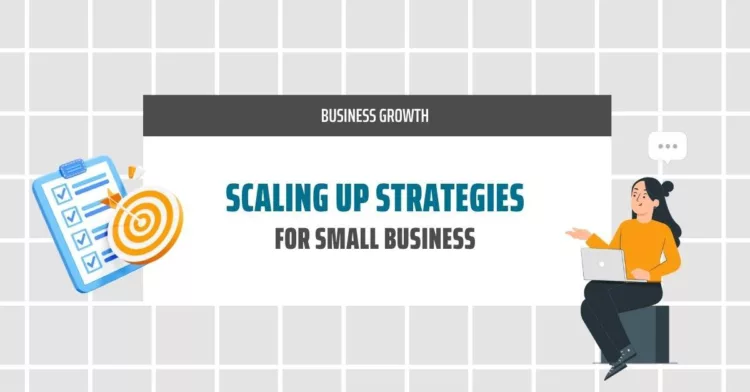Unlock Small Business Success: Proven Growth Strategies for 2024

Small businesses operate in a dynamic landscape. This guide provides crucial strategies for sustainable growth, encompassing scaling up, market penetration, tech optimization, and customer loyalty. It's your roadmap to success in today's competitive business world.
Introduction
Starting a business is undoubtedly thrilling, but let's face it - it's no walk in the park. Small businesses often face early closures. To increase your odds of success, you need to be smart from the get-go.
If you're new to entrepreneurship, you're probably brimming with enthusiasm and readiness. That's fantastic, but here's the deal: you must channel that energy and resources wisely. Without a clear plan for business growth, your startup may struggle to take off.
To stay ahead of inflation and reinvest in your business, targeting an annual growth rate of at least 15 percent is vital. This often requires a multifaceted approach, involving various tactics simultaneously.
Scaling Up: Growing Your Small Business
Scaling up your business in 2023 requires a well-rounded strategy that integrates various tactics. If you're looking to expand, here are some growth strategy tips to leverage.
Create a Growth Plan for Your Small Business
Begin with a robust plan. Seek assistance from your local small business development center to expertly map out your growth strategy. They can guide you on securing funding, especially if you're considering raising investment capital. Follow these steps:
- Collect data on current sales, distribution, profit margins, pricing, and costs.
- Research potential price adjustments to manage costs.
- Calculate the necessary growth for the next 1-5 years to ensure business viability.
- Evaluate your products and services, highlighting top performers and areas needing improvement.
- Develop a competitive strategy, whether through pricing, quality, or targeting a new market segment.
- Conduct a cost-benefit analysis for each growth investment, set revenue goals, and adapt your plan as needed.
Tending to Your Current Customers
Focus on both horizontal and vertical growth. Don't overlook your current customers; instead, enhance customer service to build loyalty. Traditional businesses benefit from personal connections, but use metrics to track and understand your regular customers. Offer discounts in exchange for feedback, providing valuable insights for both existing and new customers. Implement customer loyalty programs and collect testimonials.
Focusing on Marketing to New Customers
Develop a customer acquisition strategy for new sales channels. Utilize digital marketing, beginning with your website, to share product information, offer discounts, and build trust. Set annual marketing goals to expand your reach, incorporating tactics like newsletters or learning centers. Offer first-time purchase discounts and explore partnerships with other businesses for cross-promotion. For more on boosting your marketing efforts, explore how AI can make your marketing efficient.
Optimizing Tech and Automation
Investing in technology can enhance productivity and reduce costs. Identify the most time-consuming tasks and research tech solutions, such as payroll software that generates pay stubs efficiently. Develop a tech strategy, incorporating applications and software for inventory tracking, bookkeeping, pricing, and more. Establish a digital storefront, website, and social media presence if you haven't already.
Hiring Customer-Focused Employees
As your business scales up, you can't do everything alone. Implement a hiring strategy focused on attracting employees with digital marketing, customer service, and tech skills. If hiring full-time staff isn't feasible, consider outsourcing core functions like marketing and bookkeeping. Investing in a capable team allows you to concentrate on developing new products and building lasting customer relationships.
Market Penetration
Market penetration is a smart strategy for scaling up your small business. It involves increasing your market share by selling more of your existing products or introducing new ones to attract customers. Here's how you can do it:
- Enhance Your Products and Services: Continuously improve your products and services based on customer feedback. Ask your customers what they like about your products and if they have any suggestions for improvement.
- Take Your Business Online: Boost efficiency and productivity by selling your products or services online. This not only reduces costs but also allows better communication with customers and suppliers. Use analytics software to understand how customers interact with your website and make improvements accordingly.
Market Development
A solid market development strategy is crucial for reaching new customers while retaining existing ones. This is especially important if your product sales have plateaued or you're aiming to expand your market reach. Consider the following:
- Increase Sales to Existing or New Customers: Boost sales by either attracting new clients or retaining existing ones. Encourage repeat business, win back customers who stopped purchasing, and keep track of product sales and customer behavior.
- Expand Outside Your Locality: Collaborate with wholesalers, retailers, and distributors to expand your business beyond your local area. Consider franchising as a way to permit another company to operate under your brand.
- Review Your Prices: Compare your prices with competitors to identify pricing and margin mismatches. Offer discounts strategically to increase sales without compromising profitability. Consider adjusting prices for a more substantial profit, even if it may lead to a reduction in sales. For financial guidance, seek support from small business accountants or a Chief Financial Officer (CFO) to maximize profits and reduce expenses efficiently. For more insights, check out how to determine your niche.
Mergers and Acquisitions
Instantly grow your business by merging with or acquiring another company. While independent growth is wise initially, consider:
- Acquiring smaller companies for control.
- Merging with a business on equal footing.
Mergers and acquisitions can turn both companies into an improved business hub. From mergers to market penetration, choose the strategy that aligns best with your goals to propel your business forward.
Conclusion
In conclusion, driving growth for your small business in 2023 involves strategic planning, customer-centric initiatives, effective marketing, technological optimization, and building a skilled team. Begin by creating a well-thought-out growth plan with guidance from your local small business development center. Never underestimate the power of focusing on your current customers through loyalty programs and personalized service. Simultaneously, reach new markets by developing a robust marketing strategy that leverages digital channels and partnerships. Embrace technology to streamline operations and consider hiring employees with essential skills for sustained growth. By following these steps, you position your business for long-term success in an ever-evolving market.
The Art of Effective Web Design for Conversions
Related articles:
